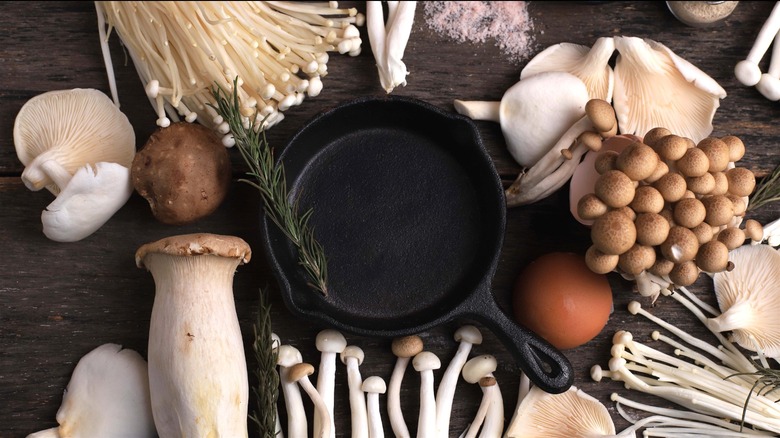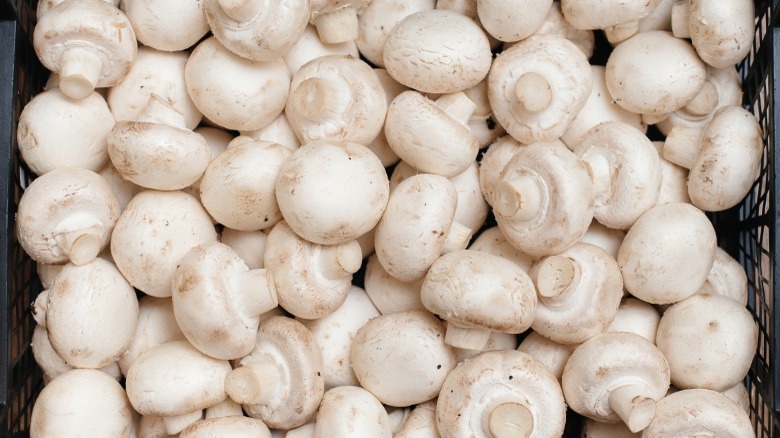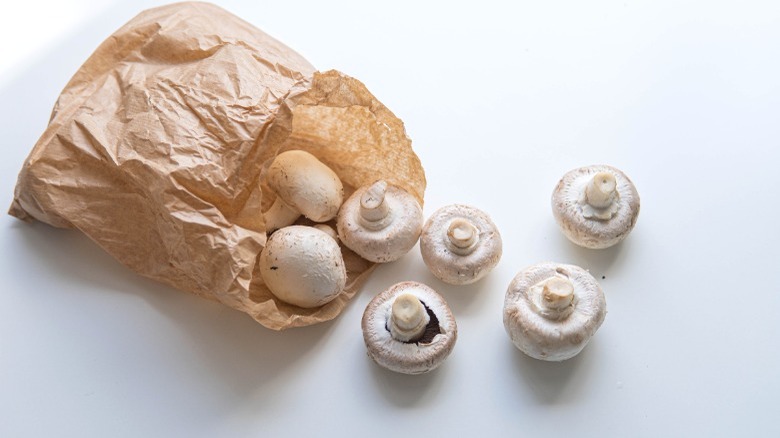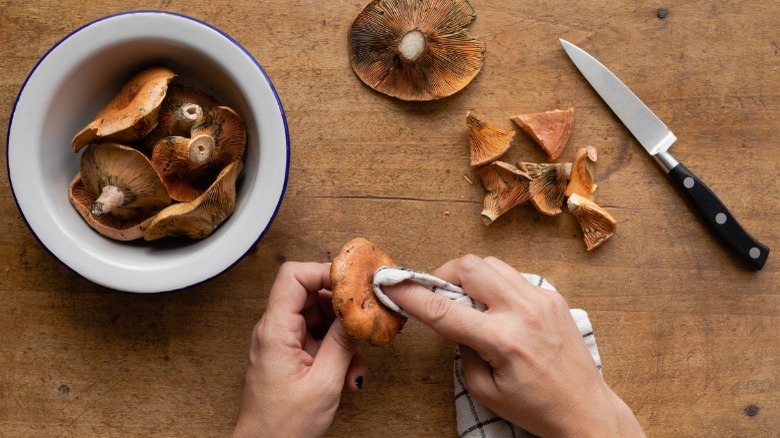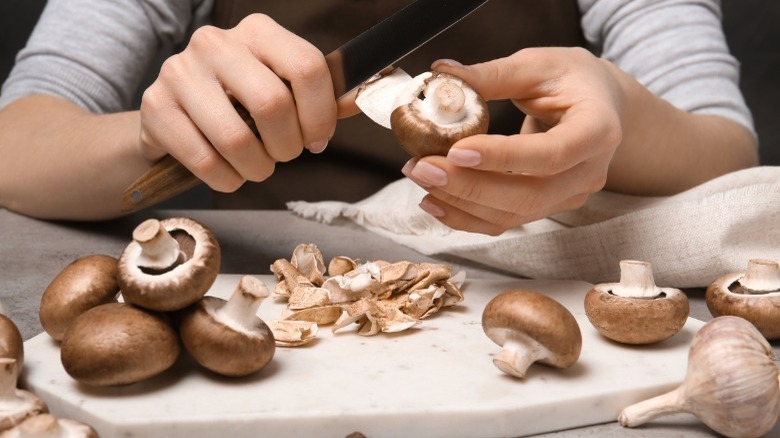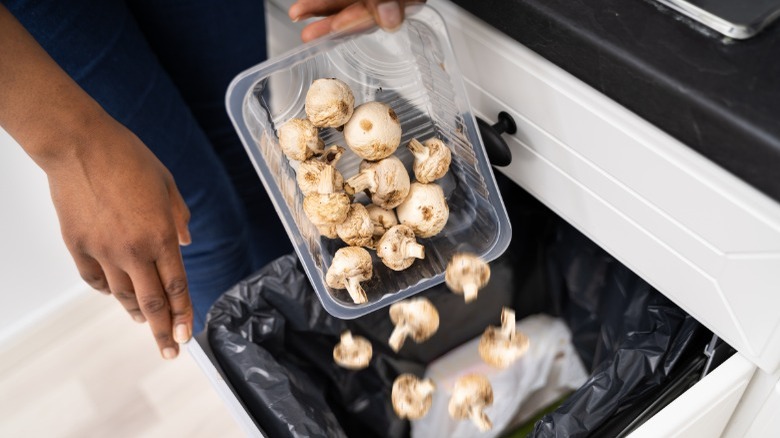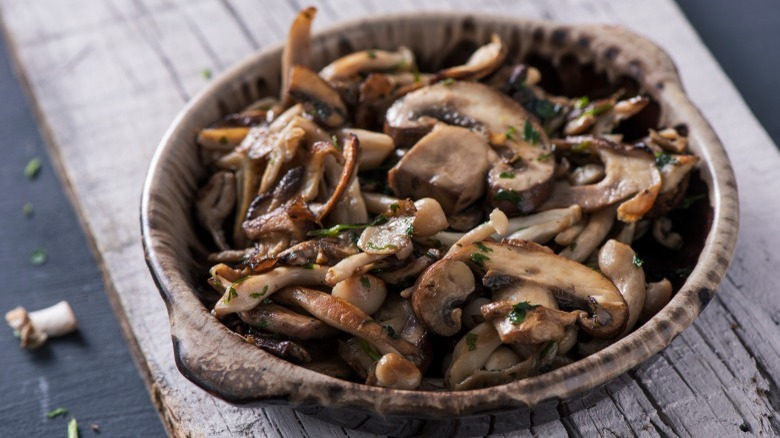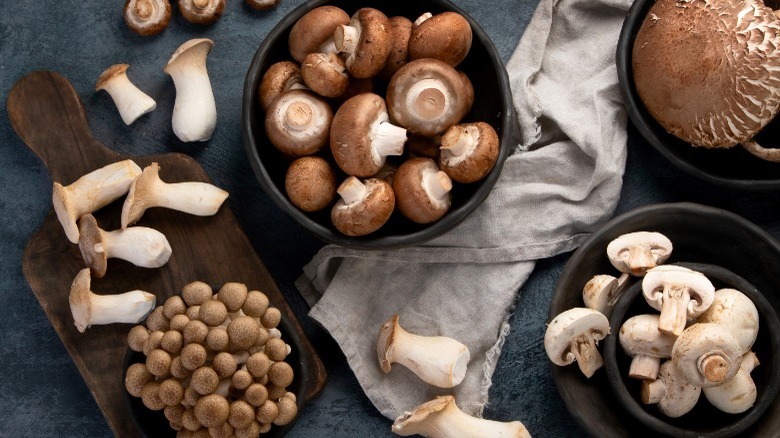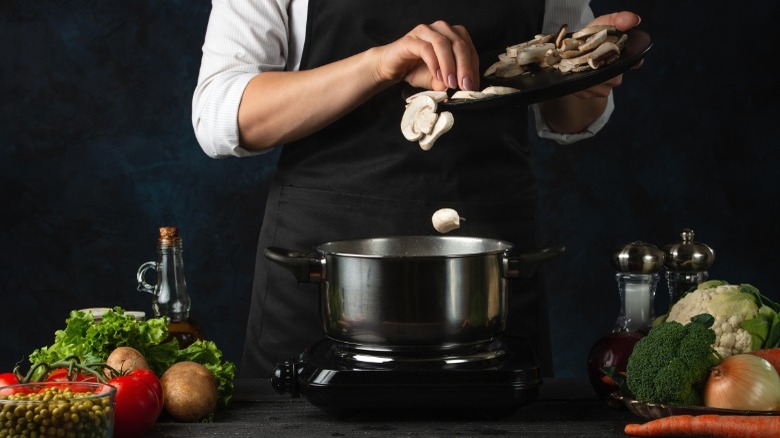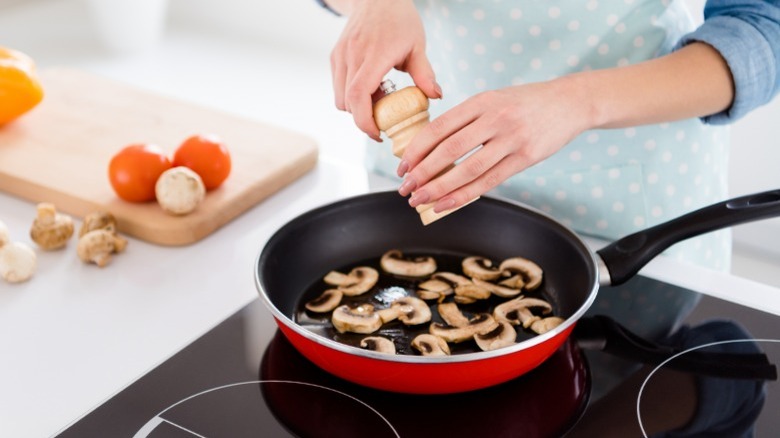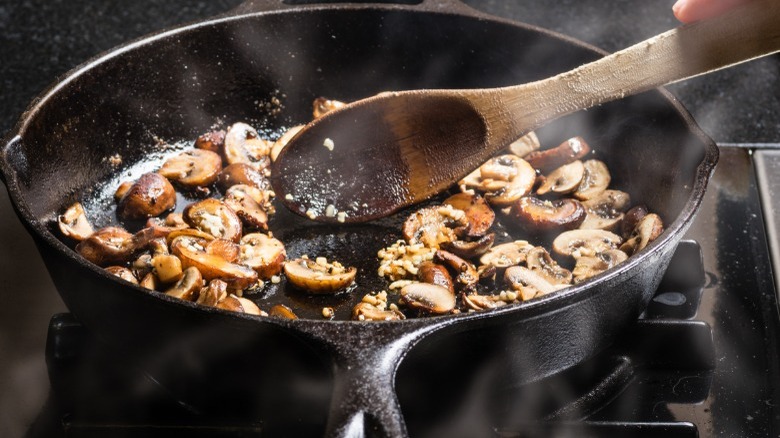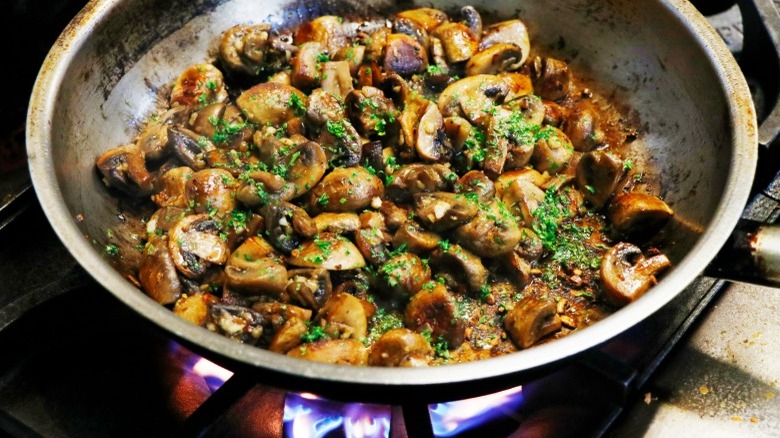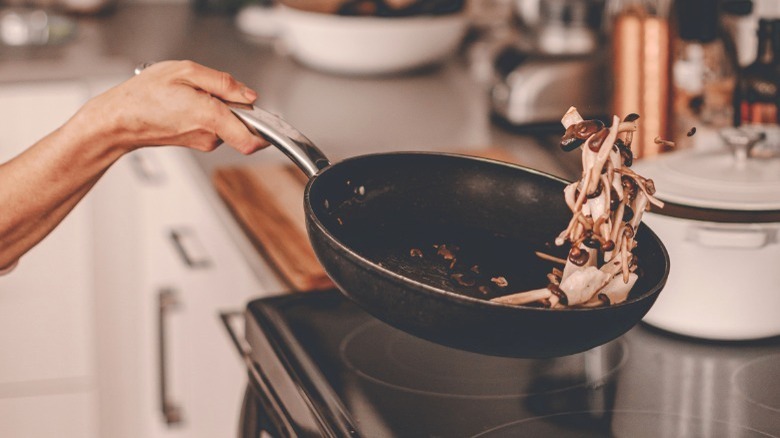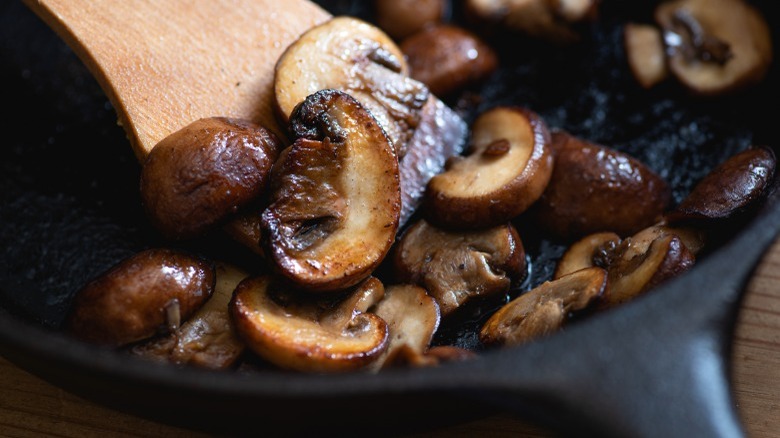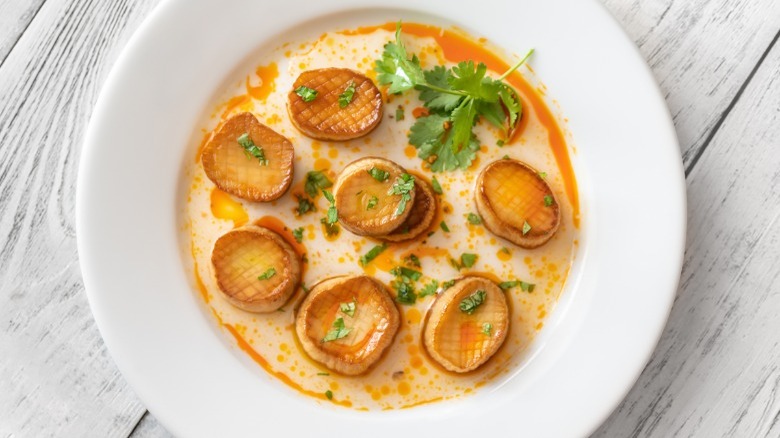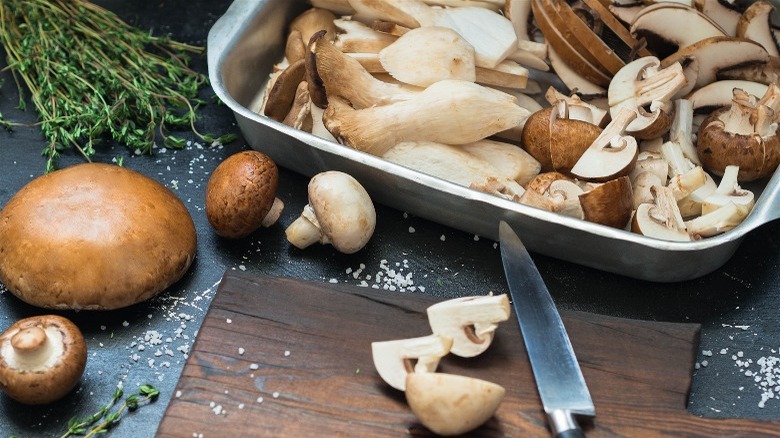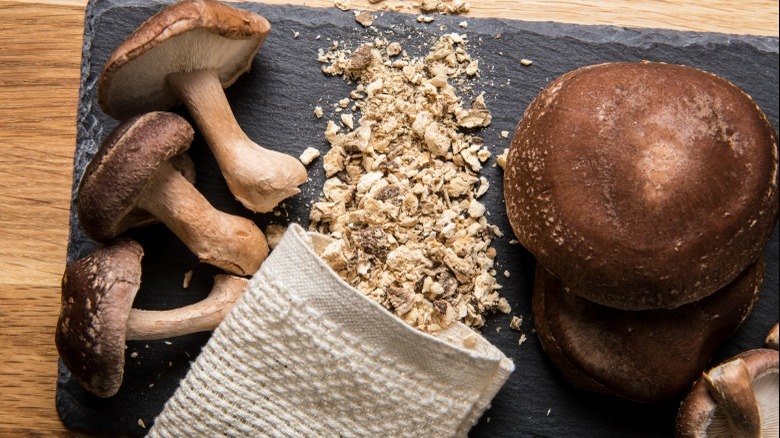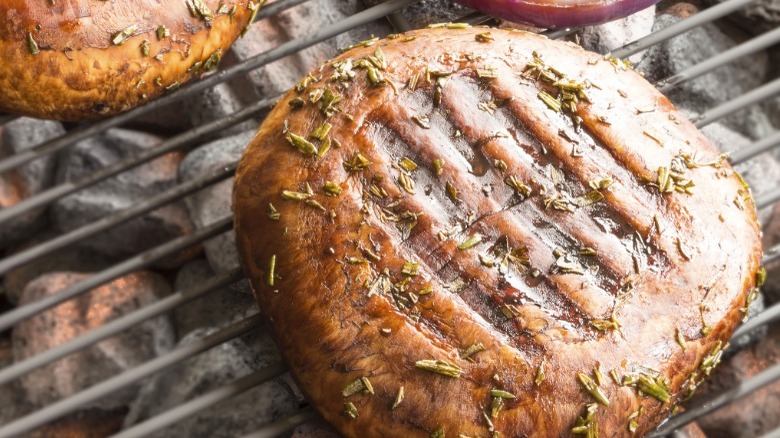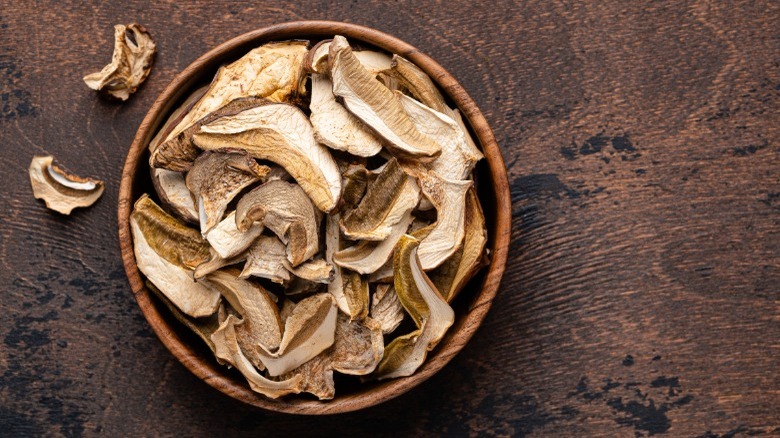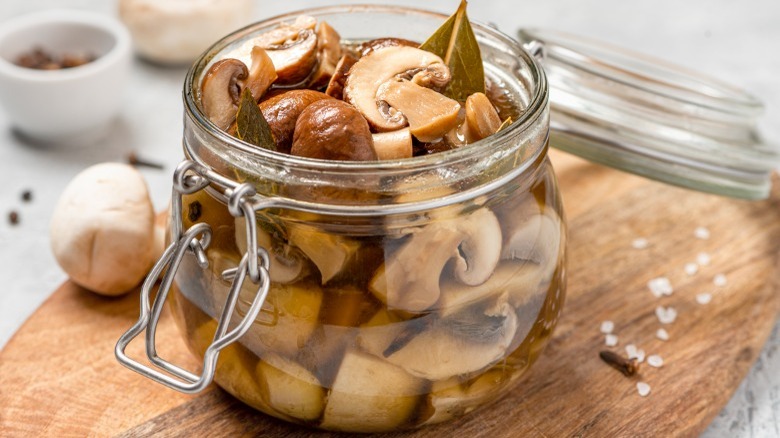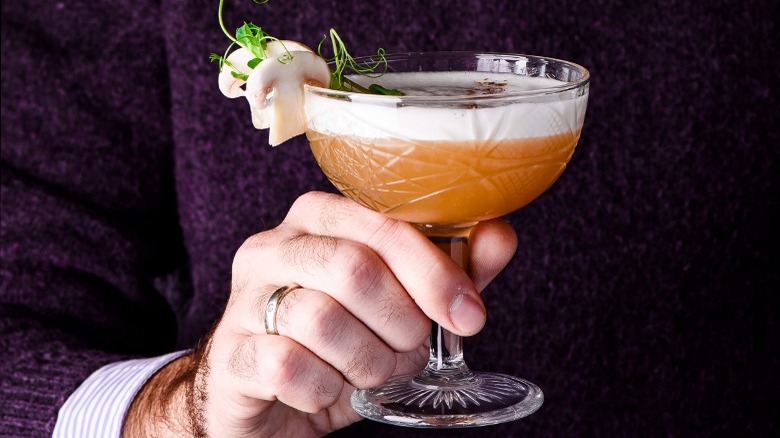20 Tips You Need When Cooking With Mushrooms
Whether you're looking for a delicious way to add some extra nutrition to your meals or just want to try something new, cooking with mushrooms is an excellent way to make your diet more varied. Not only are mushrooms incredibly versatile, but they can also add a unique texture and an umami boost to your dishes — soups, stews, meat substitutes, and even drinks. Looking for wild mushrooms in the woods can be an adventurous experience, but even if you forage at the supermarket, they can still inspire culinary creativity.
While cooking with mushrooms isn't all that complicated, they are surrounded by an air of mystery. They're not an animal or a plant, so the regular culinary rules don't always apply. That's probably why everyone believes a host of false mushroom facts and keeps making the same mistakes when cooking them. Regardless of whether you're a beginner or a pro in the kitchen, we've got the tips you need to make the most of cooking with mushrooms. From storage tips and the best types of mushrooms for different recipes to proper cleaning and cooking techniques, you'll be sure to find the answers to all your mushroom-related questions here. So, let's get started and explore the fantastic world of fungi.
Select quality mushrooms
To make sure your mushroom-starring dishes are a success, using fresh and high-quality fungi is essential. Despite the perceived convenience of it, you might want to stop buying pre-packaged mushrooms. For one, it's harder to assess their quality and freshness. Additionally, they can be more expensive. To get the best quality and value, it's best to select mushrooms by hand. Many grocery stores have bulk bins, so you can get the exact type and amount that you need. If you have access to a farmers' market, that's even better. Wherever you choose to buy them, select mushrooms that are firm and smooth with no signs of wilting or discoloration. Also, avoid slimy and moldy mushrooms. And remember, the fresher the mushrooms, the better the flavor.
Keep them fresh
To ensure your favorite fungi's freshness, it's important to store them properly. Some of the best ways to store mushrooms include wrapping them in paper towels and storing them in an unsealed plastic or paper bag. That way, any excess moisture will be absorbed, but the mushrooms won't dry out. Of course, you can always leave them in the original packaging and use them up within a couple of days after buying.
Keeping them out of your produce drawer is another easy way to extend the life of mushrooms, as it's best to store them in a less humid place in the fridge. Finally, if you have any leftover mushrooms, be sure to dry them out in the oven or cook and freeze them in batches.
Make sure they're clean and dry
The best way to clean mushrooms has always been a polarizing subject, considering it's so easy to ruin them with water. Fortunately, industry pros agree on some ground rules. With cultivated mushrooms, simply wiping them with a damp cloth or paper towel is enough.
Wild mushrooms, on the other hand, need a more thorough cleaning. To get rid of the dirt, place them in a bowl of cold water and gently stir. Then scoop any dirt that comes to the surface with your fingers. You should also stop peeling mushrooms to clean them, as their skins are edible and add more flavor to any dish. Even if you do rinse them, avoid letting them soak. Once your mushrooms are dirt-free, you should pat them dry to ensure proper caramelization.
Prep them properly
After you have successfully cleaned your mushrooms, some extra prep is often required before they are ready to be cooked. You might already be removing the stems and gills of shiitake and portobello mushrooms, but you should also score their caps, which will help release any excess moisture while soaking in the flavors.
Cremini and button mushrooms are low-maintenance, but you still need to slice them correctly — thin for pizza, thick for soups and stews. Mushrooms reduce in size when cooked, so having bigger pieces in the pot provides more texture. A non-serrated knife is the best tool for clean cuts, but you could use an egg slicer instead. In turn, oyster mushrooms don't even need to be sliced — reserve the knife for removing their stems, and tear the rest apart with your hands.
Educate yourself on food safety
Mushrooms are an incredibly versatile ingredient, but they come with some food safety considerations. First, prioritize freshness. You're risking your health when you eat old mushrooms, as they might cause E. coli infection or even botulism, which can be fatal. If you have ever wondered whether it's safe to eat moldy mushrooms, the answer is no. Better safe than sorry! On the other hand, the gills on portobello mushrooms aren't dangerous, but they do alter the color and flavor of the final dish, so you might want to remove them.
What about leftover mushrooms? There is a reason you shouldn't reheat mushrooms in the microwave, and it has everything to do with proper storage. Cooked mushrooms must be refrigerated in an airtight container within a couple of hours, or they will change their protein structure and develop bacteria. Reheating improperly stored mushrooms can amplify that process, so eating leftovers cold or tossing them is best.
Get the most nutrients
Mushrooms are rich in heart-healthy beta-glucans, B vitamins, potassium, and antioxidants, making them a great addition to any balanced diet (via Healthline). Cooking them is a great way to get the most out of their nutritional value. This is especially true for white button mushrooms: eating them raw is possible but not recommended, as they contain a carcinogenic toxin called agaritine, which is destroyed during cooking (via NutritionFacts.org).
To maximize nutritional intake, avoid frying or boiling, which can destroy some beneficial nutrients. Instead, opt for microwaving — the most nutritious way to cook mushrooms. Alongside grilling, it's the method that increases the antioxidant content and helps preserve water-soluble B vitamins and potassium. Additionally, agaritine decreases by 65% when freshly-sliced mushrooms are heated in the microwave for a single minute, making it the preferred cooking method for health-conscious mushroom lovers.
Pick the right mushroom for the job
With so many varieties available, it can be difficult to know which type of mushroom is best for the dish you're making. The key to picking the right one is to consider the flavors and textures you want to achieve. For example, button and portobello mushrooms are best for eating whole (stuffed or grilled). Oyster mushrooms work well as a vegan meat substitute, while shiitake mushrooms are best for stir-fries or umami-packed soups. Enoki mushrooms make a delightful bowl topping, while porcini will take your risotto to the next level. Then there are more exotic varieties like morels and truffles, which can add a unique flavor to any dish. Understanding the different types of mushrooms and how to best cook them will help you pick the right ones for the job.
Cook them twice
If you want to make delicious meals with mushrooms, pre-cooking them is a must. When you do so, you give them a chance to release their water content, which is what makes them perfect for putting on pizza or tossing in a salad without making everything soggy. Interestingly, one way to achieve that is to shallow boil them to evaporate their own moisture and only then add oil and aromatics.
Don't worry about them losing flavor or texture due to extra heat exposure, as it's basically impossible to overcook mushrooms. That's because their cell walls are made of chitin, which is highly resistant to heat, unlike animal proteins or pectin found in fruits and vegetables. So you can let your mushrooms caramelize and develop a deeper flavor first and then safely add them to other dishes.
Don't rush the salt
Mushrooms are an incredibly versatile ingredient and can be used in everything from salads to stir-fries. But the key to getting the most out of them is knowing when to season them. Many people make the salt mistake when cooking mushrooms by adding both to the pan at the same time. This robs the mushrooms of their natural flavor and can make them tough and chewy.
The best time to season mushrooms is towards the end of cooking or right after. Once the mushrooms have been cooked through, add a sprinkle of salt and let them cook for a couple more minutes. This will help bring out their flavor without ruining the texture. You can also add other aromatic herbs and spices to give them more flavor.
Space them out
If there's one mistake you must avoid when cooking mushrooms, it's overcrowding the pan. When you place too many mushrooms in a pan at once, they release too much moisture and end up steaming rather than sautéing, which results in a soggy, unappetizing texture.
To get the best sautéed mushrooms, follow Julia Child's advice and make sure you give them room to cook. This means using a large enough pan that will allow the mushrooms to spread out and the moisture to evaporate quickly. Additionally, it's important to make sure the mushrooms are dry before you put them in the pan, as any excess moisture will prevent them from crisping up. Finally, don't forget to season your mushrooms — a sprinkle of salt and pepper will help bring out their flavor.
Watch the time and temperature
Cooking mushrooms usually goes one of two ways: low and slow or hot and fast. Both techniques have their merits and will depend on what you're making. For instance, if you're making a mushroom and barley soup, you'll want to use the low and slow method. This will give the mushrooms time to absorb the flavors and become really tender. On the other hand, if you opt for a classic sautéed mushrooms recipe, the hot and fast method will give them a nice, crispy texture.
Additionally, if you're improvising with what's available, keep in mind that wild mushrooms cook longer than store-bought. So no matter what dish you're making, be sure to pick the mushrooms and the cooking technique that best suits your needs.
Resist the urge to stir
If you want perfectly fried mushrooms with a beautiful caramelized look, resist the urge to stir. It might be tempting to hover with a spatula to make sure they cook evenly, but the more you stir, the less likely they are to develop that caramelized look. Meddle too much, and they will release moisture and never get to that golden brown stage.
To make them crispy, you need to give them time to fry in their own juices. It's best to let them sit for the first few minutes before carefully flipping them over. You'll want the heat to be high, but make sure to adjust the temperature to avoid burning. If you're patient and vigilant, you'll end up with perfect fried mushrooms.
Use the steam-and-sear technique
To create a perfectly tender and juicy mushroom texture, try the steam-and-sear technique. It works by first dry sautéing the mushrooms to cook off any excess juices. Then, once the juices have evaporated, you can add a little oil to the pan and sear the mushrooms to add a nice caramelization. This will help to deepen their flavor while requiring less oil than a traditional sauté.
To get perfectly grilled mushrooms, follow a similar logic: steam, then sear on the grill to keep all that flavor intact. This quick and simple method will ensure that your mushrooms come out tender and umami-packed every time. Plus, it's a rule that's okay to break — no one has to know that you're not following the traditional way of preparing mushrooms!
Flatten them for a perfect crisp
If you fail to get a perfect sear on your mushrooms, you might be making one major mistake: not flattening them. That's right — the biggest mistake people make when cooking mushrooms is not squishing the mushrooms in the pan. Doing so allows for even cooking, creating a perfect crisp with a deep golden brown color.
It's essential to heat the pan well before adding the mushrooms, or else they won't sear. To achieve that effect with king oyster scallops, simply press down on each mushroom with the back of a spoon, or use a plate or a smaller pan if you're making oyster mushroom steak. After the mushrooms have been seared, feel free to lower the heat and add seasoning. It's a small but important step that will take your mushroom flavor and presentation to the next level.
Drain the juices when roasting
Roasting mushrooms can be tricky — if you don't do it correctly, you can end up with a disappointing mushy mess. But with the right technique, you can get perfectly roasted mushrooms every time. The key is to drain the juices halfway through roasting. Mushrooms have a notoriously high water content, and if you throw them in a pan and leave it in the oven, the moisture they exude will cause them to steam instead of roast.
The solution? Drain the juices that will have accumulated at the bottom of the pan after the first 10 or 20 minutes in the oven, and you will up the crispiness in addition to cutting down the cooking time (via Real Simple). But don't forget to save the juices — they can be reused in soups, sauces, and stews for an extra boost of flavor.
Keep the stems, gills, and peels
Many mushrooms come with tough, woody, or fibrous stems, dark gills, or peelable skins that are typically discarded in cooking, as they seem difficult to use. But it's worth considering repurposing them before putting them in the compost. For one, stop wasting your mushroom stems — mince them up and use them in stocks, gravies, stuffing, or anywhere you'd want more umami, or dry them to make flavorful mushroom powder. The gills of portobello mushrooms are often removed for practical or aesthetical purposes, but they're safe to eat and can be reserved for mushroom stocks.
Finally, think twice before throwing out old mushrooms — the fact that they dried out a bit and aren't as visually appealing anymore doesn't mean you can't use them in pasta or soup. Getting creative with mushroom odds and ends is a great way to make the most of them while lowering food waste.
Turn them into meat substitutes
When it comes to creating plant-based imitations of animal products and dishes, fungi have unmatched potential. To transform mushrooms into vegan bacon, all you'll need is to season them with soy sauce and paprika for that smoky, savory flavor and chewy texture. Oyster mushrooms make a great substitute for breaded fried chicken, and shiitake mushrooms can be used instead of pork in steamed buns.
Mushrooms can also be used to make vegan-friendly versions of seafood. Seared slices of king oyster mushrooms perfectly imitate scallops, and Tabitha Brown swears by her game-changing substitute for vegan shelled seafood: enoki mushrooms. With a bit of creativity, mushrooms can be used to create any number of vegan-friendly dishes, thanks to their unique texture and umami-rich flavor.
Up the umami with dried mushrooms
If you're looking for a way to enhance the flavor of your savory dishes, look no further than dried mushrooms. Whole or powdered dried mushrooms are a potent source of umami, which can make your dishes taste more complex. Dry mushroom powder is incredibly versatile: it can deepen the flavor of soups, sauces, batters, and drinks. You can dry your own mushrooms (especially those leftover stems) and powder them or use store-bought.
You can also make your own vegetable broth with mushrooms in just a few simple steps. First, you soak dried shiitake mushrooms, then strain and cook the liquid with alliums and herbs. The result is a deeply flavorful and highly versatile broth that you can even drink on its own or apply as usual.
Marinate mindfully
Marinated mushrooms are a delicacy, and making them yourself could be a way to experiment with different flavors, but it must be done with care. When pickling mushrooms, you should keep in mind that they are not plants and therefore play by different rules.
Most importantly, their porous texture allows them to absorb flavors very quickly, so it is important to keep them submerged for the right amount of time. Too long in the marinade and the mushrooms will become overly saturated, but too short a time in the marinade and it won't have a chance to penetrate the mushrooms. Taste them after about half an hour, and decide whether you want to marinate further. Finally, remember to keep the jar refrigerated until ready to use — you want your pickled mushroom toast to taste as fresh and exciting as possible.
Elevate cocktails with mushrooms
That's right: Mushrooms aren't just for eating. In fact, they can be used to create some seriously delicious drinks. As unconventional as it may seem, mushrooms can elevate your cocktails in ways you never imagined. They add complexity and depth, as well as a unique texture and aroma.
You can use everything from dried mushrooms to mushroom-infused syrups and bitters to elevate your drinks. For example, try infusing vodka with dried porcini mushrooms for a unique take on a martini. Or, use mushroom-infused bitters to add a smoky, earthy flavor to your favorite drink. In terms of flavor combinations, the rich mushroom umami pairs nicely with either earthy or herbal flavors and is highlighted by spicier and more fruity tastes. The possibilities are endless!
